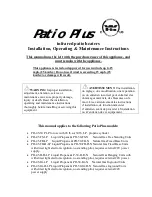
Maximum Vent Length:
Direct Vent Maximum Vent Length (Combined Maximum Length for Intake and Exhaust)
Storage
Capacity
(Gallons)
Rated Input
(BTU/HR)
Max Vent Length (feet)
3" PVC, CPVC, or ABS
Max Vent Length (feet)
4" PVC, CPVC, or ABS
60 125,000
120
170
60 150,000
100
150
60
100
100
100
100
100
199,000
150,000
199,999
250,000
300,000
399,999
80
120
100
80
60
50
130
170
150
130
110
100
Table 3
Note: The venting distance shown in the chart above is the combined maximum distance for
the intake and exhaust pipe and elbows.
Determining required vent length:
1. Determine the total length of straight vent pipe (in feet) required for both the intake and the exhaust.
2. Add 5 feet of venting for every 90° elbow.
3. Add 2 ½ feet of venting for every 45° elbow.
4. Total vent length cannot exceed “Max Vent Length” in Table 3.
5. Air intake cannot exceed exhaust by more than 30 feet in any venting situation.
Example of Total Direct Vent Length for 100 gallon 199,999 btuh model:
A 3” venting system has a total of six 90-degree elbows and a total straight pipe length of 65 feet
(includes both intake and exhaust pipe).
Equivalent vent length for elbows: 6 x 5 feet = 30 feet.
Total equivalvent vent distance = 65 feet + 30 feet = 95 feet total equivalent vent length. This is
below the maximum allowed distance of 100 feet for this model using 3” vent.
NOTICE
Do not include the 3” condensate elbow or vent terminals in determining maximum vent
length
.
POWER VENT INSTALLATION
Power venting is where the indoor air is used and the exhaust is vented to the outside. Venting may be run horizontally
through an outside wall or vertically through a roof through using either 3 inch (7.6 cm) or 4-inch (10.2 cm) diameter
PVC, ABS or CPVC. This water heater is supplied with a screened intake and exhaust 90° elbow referred to as the
exhaust vent terminal and the air intake terminal.
Power Vent Terminal Location
Refer to the “Direct Vent Terminal Location” section previously mention to determine the proper exhaust vent
location. Plan the vent system layout so that proper clearances are maintained from plumbing and wiring.
Vent pipes serving power vented appliances are classified by building codes as “vent connectors”. Required
clearances from combustible materials must be provided in accordance with information in this manual under
LOCATION OF WATER HEATER, and CLEARANCES, and with National Fuel Gas Code and local codes.
24
Содержание U.H.E
Страница 47: ...NOTES 47...
















































